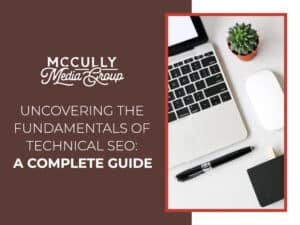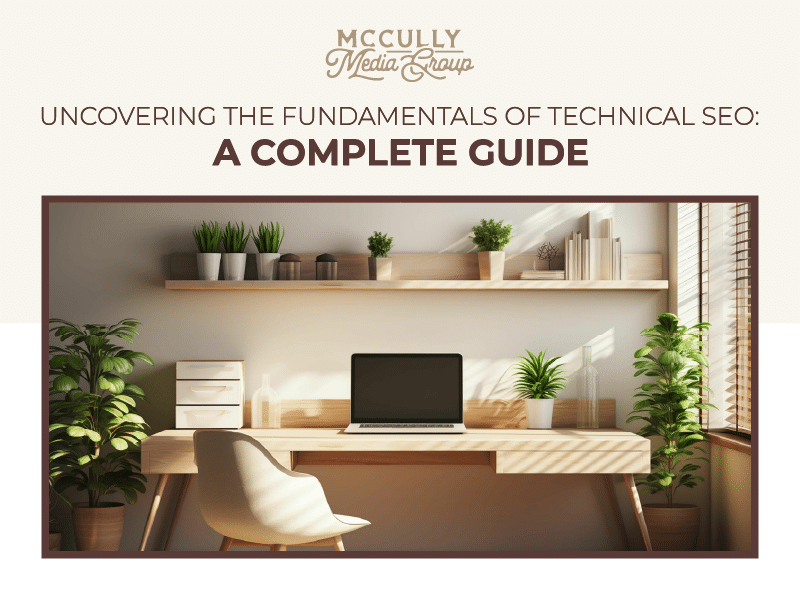Technical SEO, a powerful facet of search engine optimization (SEO), delves into the intricate mechanisms and intricacies that govern search engines’ comprehension and evaluation of your website, which ultimately influence its ranking in search results. It invovles the skeleton of your online presence, comprising everything from website architecture to webpage speed, each of which directly impacts how search engines crawl, understand, and rank your content.
Technical SEO is not just a luxury; it’s a necessity. In the vast digital landscape, search engines are your potential customers’ guide, leading them to your door. If your site is technically sound and designed with an understanding of user intent and compelling storytelling, it stands a better chance of earning a high-ranking position in search engine results pages (SERPs).
To understand user intent and weave storytelling into your SEO strategy, it’s beneficial to use the StoryBrand framework by Donald Miller. This seven-part framework clarifies your message so your website communicates with customers effectively. It emphasizes the importance of defining a character (your customer), understanding their problem, and offering them a solution, ultimately guiding them to success. Using this framework in conjunction with technical SEO ensures that your site ranks well and resonates with users on a deeper level.
On-Page Technical SEO Tips

Photo by Pexels
The following are some essential technical SEO practices to implement on your site:
Keyword Research and Optimization
Keyword research forms the bedrock of any successful SEO strategy. To truly resonate with your target audience and cater to their specific needs, you need to embrace the language and vocabulary they naturally employ. In particular, giving precedence to long-tail keywords that harmonize with the user’s underlying intent will significantly enhance your ability to connect with and capture the attention of your desired audience.
Meta Descriptions and Title Tags
Meta descriptions and title tags provide concise summaries of your webpage’s content. They should be compelling, include relevant keywords, and accurately represent the content.
URL Structure
Optimize URLs to be user-friendly and easily understandable for both humans and search engines. Each URL should contain the target keyword and accurately describe the page content.
Image Optimization
Ensure all images include relevant alt tags with descriptive text, providing context for search engines and aiding accessibility for users with visual impairments.
Internal Linking
Internal linking helps spread link equity around your site and aids in site navigation. Aim to include relevant internal links on each page, linking to related content where possible.
How to Optimize Your Site Structure for Technical SEO

Photo by Pexels
The structure of your site is a significant ranking factor. An easy-to-use site structure not only helps your site visitors navigate easily but also improves the ability of search engines to crawl through your site.
Optimizing your site structure involves following these best practices:
Logical Hierarchy
Your site should be organized in a clear, logical manner. This means grouping related pages together under appropriate categories and subcategories.
Navigation
Make sure that the main menu provides easy access to all significant pages. Ideally, users should be able to navigate to any page on the website within three clicks.
Breadcrumb Navigation
Breadcrumb navigation gives users a clear path back to previous pages. This not only improves user experience but also aids search engines in understanding your site’s structure.
XML Sitemap
An XML sitemap is a roadmap for search engines, listing all the pages on your site. This aids search engines in crawling your site more efficiently.
Best Practices For Site Speed and Mobile Usability
With Google’s focus on user experience, site speed and mobile usability have become essential factors in SEO. A slow-loading website or one that doesn’t display correctly on mobile devices can lead to high bounce rates and lower rankings.
To improve site speed, consider implementing techniques such as enabling browser caching, optimizing images, and minimizing HTTP requests. For mobile usability, ensure your website is designed responsively to adapt to different screen sizes and provides a seamless user experience on mobile devices.
Troubleshooting Common Technical SEO Issues
Performing regular technical SEO audits is crucial to identify and address any issues that may be impacting your site’s performance.
Here’s a checklist to guide your audit:
Website Indexing
To ensure that your website is being indexed correctly by search engines, use the “site:” operator on a search engine and check if your web pages show up in the search results.
Crawl Errors
Identify and fix any crawl errors reported by search engines. These errors can prevent search engines from properly indexing and ranking your site.
Robots.txt File
Review your robots.txt file to ensure it’s not blocking any important pages or directories from search engine bots. Make necessary adjustments if required.
XML Sitemap
Check if your XML sitemap is correctly formatted and submitted to search engines. Ensure it includes all the important pages of your site.
Duplicate Content
Identify and resolve any issues with duplicate content on your site. Duplicate content can confuse search engines and dilute the ranking potential of your pages.
Broken Links
Scan your site for broken links and fix them promptly. Broken links can negatively impact user experience and hinder search engine crawling.
Page Speed
Assess your site’s page speed using tools like Google PageSpeed Insights. Elevate your website’s performance by embarking on a transformative journey toward streamlined optimization. Unleash its true potential by diligently minimizing server response time, harnessing the power of browser caching, and meticulously reducing those precious moments it takes for your pages to load.
Optimize your site’s performance by minimizing server response time, leveraging browser caching, and reducing page load times.
Mobile-Friendliness
Test your site’s mobile-friendliness using Google’s Mobile-Friendly Test. Ensure your site is responsive and provides a seamless experience across different devices.
Schema Markup
Implement relevant schema markup on your site to provide additional context to search engines. Schema markup can enhance the visibility of your content in search results.
SSL Certificate
Check if your site has an SSL certificate installed and is accessible over HTTPS. A secure site is preferred by search engines and can contribute to better rankings.
Utilizing Technical SEO Tools
In the ever-evolving digital landscape, utilizing technical SEO tools has become an essential ingredient for success, allowing businesses to unlock their full potential and thrive in the online realm. These tools act as powerful allies, providing deep insights and data-driven solutions that go beyond the surface level. By harnessing the capabilities of technical SEO tools, businesses can gain a competitive edge by identifying and rectifying underlying technical issues that may hinder their online visibility.
Combine SEO Expertise With the StoryBrand Framework
As you can see, technical SEO is crucial to the success of your website. However, if you are searching for a marketing company that offers a unique blend of technical SEO expertise and mastery of the StoryBrand framework, look no further. At McCully Media Group, we pride ourselves on being a rarity in the industry. Our team consists of experts in both technical SEO and the StoryBrand framework, ensuring that your marketing leverages the power of storytelling while optimizing your website for search engine success.
That’s because successful marketing involves more than just achieving a high search engine ranking. It entails engaging with your audience on a personal level, captivating them with a compelling story that addresses their needs and desires. Are you ready to get started? Contact us today, and let’s discuss how we can leverage both technical SEO and the StoryBrand framework to help your business rank higher in search results and create a more engaging customer experience.
Learn More:
7 Steps for Building The Perfect SEO Strategy — A Complete Guide!
Digital Marketing Trends: What’s Next for 2023 and Beyond?
This Is How to Create a Profitable Content Marketing Strategy Using 7 Essential Steps





